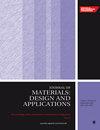天然纤维增强复合材料的均质强度准则
IF 2.2
4区 材料科学
Q3 MATERIALS SCIENCE, MULTIDISCIPLINARY
Proceedings of the Institution of Mechanical Engineers, Part L: Journal of Materials: Design and Applications
Pub Date : 2024-04-01
DOI:10.1177/14644207241242382
引用次数: 0
摘要
介绍了多层天然纤维复合材料(NFC)板的代表性模型,以研究其均质强度准则。三层 NFC 板模型用于分析多层 NFC 的局部应力应变特性。在各种边界条件下对代表性体积元素(RVE)进行有限元分析,以研究宏观和微观层面的应力和应变。对均化强度的明确评估需要计算应力张量和等效应力,以确定参数值。均化强度要求的精确规范有助于理解材料在各种加载条件下的行为,从而影响复合材料的应用设计和优化技术。这项研究考察了纤维取向角对 NFC 机械性能的影响。结果表明,亚麻纤维的应力水平相对高于棕纤维。这项研究加深了人们对天然纤维层压复合材料宏观和微观行为的理解,即材料在不同载荷下的反应。对 NFC 均化强度标准的定义改进了对其设计的评估。本文章由计算机程序翻译,如有差异,请以英文原文为准。
Homogenised strength criterion for natural fibre-reinforced composite
A representative model for multilayer natural fibre composite (NFC) plates is introduced to investigate its homogenised strength criterion. A three-layer NFC plate model is used to analyse the local stress–strain characteristics in multi-layered NFC. Finite element analysis (FEA) is performed on the representative volume element (RVE) under various boundary conditions to investigate stress and strain at macroscopic and microscopic levels. The explicit assessment of homogenised strength requires calculating stress tensors and equivalent stresses to determine parameter values. The precise specification of homogenised strength requirements assists in comprehending the material's behaviour under various loading conditions, which affects composite application design and optimisation techniques. The study examined the effect of fibre orientation angles on NFC's mechanical behaviour. The results demonstrate that flax fibres have comparatively higher stress levels than coir fibres. This study improves the understanding of natural fibre laminate composites’ macroscopic and microscopic behaviours, that is, the material's response under different loadings. The definition of homogenised strength criterion on NFC improves their design evaluations.
求助全文
通过发布文献求助,成功后即可免费获取论文全文。
去求助
来源期刊

CiteScore
4.70
自引率
8.30%
发文量
166
审稿时长
3 months
期刊介绍:
The Journal of Materials: Design and Applications covers the usage and design of materials for application in an engineering context. The materials covered include metals, ceramics, and composites, as well as engineering polymers.
"The Journal of Materials Design and Applications is dedicated to publishing papers of the highest quality, in a timely fashion, covering a variety of important areas in materials technology. The Journal''s publishers have a wealth of publishing expertise and ensure that authors are given exemplary service. Every attention is given to publishing the papers as quickly as possible. The Journal has an excellent international reputation, with a corresponding international Editorial Board from a large number of different materials areas and disciplines advising the Editor." Professor Bill Banks - University of Strathclyde, UK
This journal is a member of the Committee on Publication Ethics (COPE).
 求助内容:
求助内容: 应助结果提醒方式:
应助结果提醒方式:


